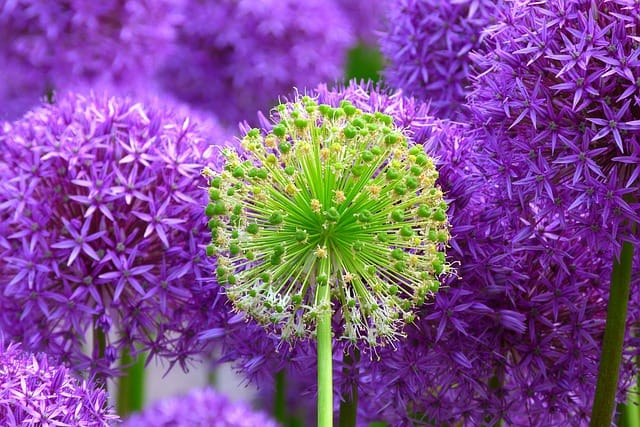How to grow Alliums
The allium flower, with its striking spherical blooms and long stems, is a favorite among flower gardeners

In this article:
- Introduction
- All About Alliums
- Choosing the Right Variety
- Soil Preparation and Planting
- Watering and Fertilizing
- Sunlight Requirements
- Controlling Pests and Diseases
- Propagation Methods
- Pruning and Deadheading
- Dividing and Transplanting
- Overwintering Alliums
- Companion Planting with Alliums
- Allium Bouquets and Cut Flowers
- Frequently Asked Questions (FAQs)
- Conclusion
Introduction
The allium flower, with its striking spherical blooms and long stems, is a favorite among flower gardeners. This article will provide you with all the information you need to successfully grow alliums in your garden. From choosing the right variety to caring for them throughout the year, we've got you covered.
All About Alliums
Alliums, commonly known as ornamental onions, belong to the onion family. They come in a variety of colors, including purple, blue, white, pink, and yellow. These stunning flowers can add height and visual interest to your garden, attracting bees, butterflies, and other pollinators.
Choosing the Right Variety
Before planting alliums, consider the available space in your garden, the desired height, and the bloom time. Some popular allium varieties include Allium giganteum, Allium azureum, and Allium hollandicum. Each variety has its own unique characteristics, so choose the ones that suit your preferences and growing conditions.
Soil Preparation and Planting
Alliums prefer well-draining soil with a pH between 6.0 and 7.5. Prepare the soil by removing any weeds or debris and incorporating organic matter such as compost. Plant the bulbs in the fall, around 2-3 times their own depth, with the pointed end facing up. Space the bulbs according to the specific variety's requirements.
Watering and Fertilizing
While alliums are relatively drought-tolerant, they still need regular watering, especially during dry periods. Avoid over-watering, as excessive moisture can cause the bulbs to rot. Apply a balanced fertilizer in early spring to promote healthy growth.
Sunlight Requirements
Alliums thrive in full sun, receiving at least 6-8 hours of direct sunlight each day. Ensure that the area where you plant your alliums has adequate sunlight and is not shaded by trees or tall plants.
Controlling Pests and Diseases
Alliums are generally resistant to pests and diseases. However, they can occasionally be affected by onion fly, thrips, or fungal diseases. Monitor your plants regularly and take prompt action if you notice any signs of damage or infection.
Propagation Methods
Alliums can be propagated from seed, but it can take several years for them to reach maturity and produce flowers. The easier and more common method of propagation is through bulb division. Divide large clumps of bulbs in early fall or early spring, and replant them in desired locations.
Pruning and Deadheading
After the allium flowers have bloomed and faded, you can remove the spent flower heads to maintain the plant's appearance. Deadheading can also prevent self-seeding and promote bulb development for the following year.
Dividing and Transplanting
Over time, allium bulbs may become overcrowded, leading to reduced flowering. To keep your alliums healthy and vibrant, dig up and divide the bulbs every few years when they become too congested. Transplant the divisions to new locations in your garden, allowing the plants to rejuvenate.
Overwintering Alliums
Alliums are generally hardy plants that can withstand cold winter temperatures. However, providing a layer of mulch around the base of the plants can offer additional protection from frost. Mulching will help conserve moisture, insulate the soil, and prevent temperature fluctuations.
Companion Planting with Alliums
Alliums make excellent companion plants. Their tall flower stalks can provide vertical interest and a contrasting backdrop to lower-growing plants. They pair well with a variety of perennials, such as roses, peonies, and salvias.
Allium Bouquets and Cut Flowers
Allium flowers are not only beautiful in the garden, but they also make stunning additions to bouquets and floral arrangements. Cut the stems when the flowers are just beginning to open and place them in a vase with fresh water. Alliums can last up to two weeks as cut flowers.
Frequently Asked Questions (FAQs)
Here are some common questions about growing allium flowers:
Q: When is the best time to plant allium bulbs?
Q: How often should I water my alliums?
Q: Can alliums be grown in containers?
Q: Do alliums attract bees and butterflies?
Conclusion
Alliums are a spectacular addition to any garden. With their unique spherical blooms and vibrant colors, they can transform your outdoor space. By following the guidelines provided in this article, you can successfully grow alliums and enjoy their beauty year after year.
